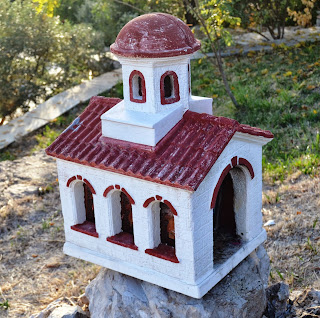 In the mountains of Greece, especially on steep roads with hairpin turns, you see many small roadside shrines, or kandylakia, which may mark lives lost (particularly in auto accidents, which are common here because Greeks tend to drive in a crazy fashion), or even lives saved. Typically, you may erect a kandylakia to your (if you are saved) or your loved one’s patron saint, such as Archangel Michael. They may be made of wood, metal or stone, and typically contain icons, votive candles, incense or photographs. They are less common on the Greek Islands because the terrain is less conducive to traffic fatalities.
In the mountains of Greece, especially on steep roads with hairpin turns, you see many small roadside shrines, or kandylakia, which may mark lives lost (particularly in auto accidents, which are common here because Greeks tend to drive in a crazy fashion), or even lives saved. Typically, you may erect a kandylakia to your (if you are saved) or your loved one’s patron saint, such as Archangel Michael. They may be made of wood, metal or stone, and typically contain icons, votive candles, incense or photographs. They are less common on the Greek Islands because the terrain is less conducive to traffic fatalities.
Continuing in the spiritual vein, on the island of Mykonos alone there are said to be 365 Greek Orthodox churches. Most are tiny buildings holding ten or twenty seats, with incense and candles burning throughout the day. They are obviously still well-used, and on Sunday we saw many church-goers at a large church in town, almost all dressed in black.
 These tiny churches contain beautiful icons (from the Greek word eikona, meaning “image”) that contain symbolism of the person or event portrayed. Free-standing statues are not generally found in Orthodox churches because of the rejection of the previous Greek Classical age’s idol worship, and because icons are designed to show the spiritual side of man, not the sensual earthly body.
These tiny churches contain beautiful icons (from the Greek word eikona, meaning “image”) that contain symbolism of the person or event portrayed. Free-standing statues are not generally found in Orthodox churches because of the rejection of the previous Greek Classical age’s idol worship, and because icons are designed to show the spiritual side of man, not the sensual earthly body.
One of the trademarks of the Greek Islands is the combination of whitewashed buildings and sky blue domes and doorways. This door and stairway is an example of the unusual and thoughtful architecture here.
We made many new friends on this trip. Here we see Mark and Anne walking down a short street lined with colorful planters made of used olive oil cans. They are delightful, fun folks who live in Oregon, and taught us a lot about The University of Oregon Ducks, whose mascot is indeed a duck, and whose logo image is actually Donald Duck, the result of a handshake between Oregon football coach Leo Harris and Walt Disney himself back in the 1940s. We had a lot in common with Mark and Anne, and as Mark and I were the only guys in week two part of the trip, we found a lot of guy things to talk about. We plan on getting together again next summer in Oregon when we head west.
There is a part of Mykonos that is called Little Venice. While there are no canals, houses and restaurants are built right on the water, with balconies overhanging the water. During the 16th and 17th centuries when piracy was common in the Cyclades, cargo from ships was offloaded quickly to the houses here. Today there are several restaurants that usually have full tables at the water’s edge, but with an onshore wind and seas running, you are liable to get wet. When I asked a waiter for a waterside table, he looked at me like I was nuts, and then laughed.
We had a half-day excursion to the archeological site on Delos, a nearby island that allows no permanent residents, only a group of caretakers and guards. Delos was a holy sanctuary for 1,000 years even before the ancient Greeks declared it to be the birthplace of Apollo and Artemis, making it one of the most important spiritual and religious centers of Greece. It was also “purified”, when in the 5th Century BC, every dead body was removed to a nearby island, and no one was allowed to give birth or die here. It became a thriving commercial center for over 1,000 years, and once had 25,000 residents. Delos was devastated when 20,000 people were killed by Mithradites VI of Pontus in 88 BC, and almost all of the remainder were killed in a brutal pirate attack in 69 BC. Because the small island had no fields or pasture land and limited water supplies, it was not self-sustaining, and became uninhabited in modern times. However it is still a rich archeological site, supervised by the French School in Athens.
This wealthy merchant’s home, the House of Dionysius, was obviously at the high end of Delos’s real estate market. It had a central courtyard with marble columns, a beautiful mosaic floor, painted marble statues, and walls decorated with colorful frescoes.
This block of marble is actually the bottom half of an olive press. Greek and later Roman occupants of this home made their own olive oil and much of their own wine this way. There were no Safeways and even fewer 7-11s here, so homemakers had to be handy. Having a few slaves captured in battle helped reduce the owners’ workload. Delos also hosted the largest slave market in the area in Greek antiquity.
There may have been an ancient inn or restaurant here, because this lovely tourist appears to be asking for a glass of wine. The waiter never showed up, though, and she had to resign herself to a bottle of mineral water and a very tasty baklava from the museum café in a modern building nearby…
Delos was founded by Greeks, but after Rome ascended to power, its citizens took over Delos and made many civil engineering improvements, including this huge fresh water storage cistern. At the time it was covered with a wooden roof.
Delos may be best known for the Terrace of the Lions, funded by the people of Naxos and dedicated to the god Apollo. Originally a dozen snarling marble lions stood here; today seven remain, their features much softened by centuries of rain and weathering. These are actually copies; the originals are protected inside the Museum of Delos nearby. There used to be a sacred lake at Delos 50 yards from the lions, but caretakers today keep the lake drained dry to suppress disease-carrying bacteria. (Our tour guide told us it was to keep down mosquitos; that doesn’t sound nearly as threatening…)
 The museum has several good pieces, but most of the best statues have been sent to the museum in Athens. This one is representative of Classical Greek sculpture. Statues were generally not representative of specific people, but of a stylized ideal. They were also almost always painted, rather than bare marble.
The museum has several good pieces, but most of the best statues have been sent to the museum in Athens. This one is representative of Classical Greek sculpture. Statues were generally not representative of specific people, but of a stylized ideal. They were also almost always painted, rather than bare marble.
This was the Temple of Isis, built in the Doric style during the Roman occupation to honor the Egyptian goddess Isis (revered even in Rome as the ideal mother and wife, and the patroness of nature and magic). It was probably used until the 4th Century AD when decrees by recently converted to Christianity Roman Emperor Theodosius led to pagan temples being destroyed.
Finally, it was with a bit of historical whimsy that on the ferry to/from Delos, one fellow passenger was dressed in a decidedly modern outfit that ancient Greeks and Romans might find a bit bizarre. In fact, I myself found his outfit, which included plastic shorts, more than bizarre. Where is he from, another planet?



